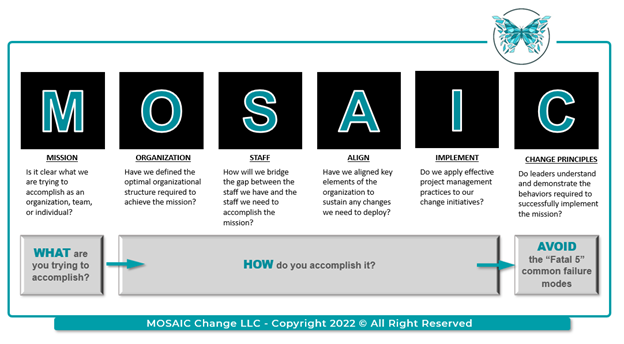ATD Blog
3 Simple Operating Principles for TD Pros to Improve Credibility With the C-Suite
Wed Mar 20 2024

In today’s fast-paced and competitive business environment, talent development professionals can play a pivotal role in shaping organizational success. However, gaining credibility with the C-suite requires more than just delivering training programs or implementing talent initiatives. It demands a strategic approach rooted in three key operating principles. Let’s delve into these principles and explore how they contribute to establishing credibility with top leadership.
1. Embrace a standard organizational effectiveness framework to drive a common language with leaders.
One way to improve your credibility with leadership is to adopt a comprehensive organizational effectiveness framework, such as the simple MOSAIC Change model shown in the following image:

While each organization is unique, having a standardized framework enables professionals to assess problems more holistically and identify underlying issues systematically. Without a common language to describe what “good” looks like, leaders often fail to accurately assess organizational challenges and struggle to link talent development to the resolution of critical organizational challenges.
An effective organizational framework encompasses various dimensions, such as leadership alignment around a common strategy, an appropriate organizational structure, the quality and availability of key talent, standard management practices, or effective leadership behaviors. By using such a framework, talent development professionals can help leaders gain insights into the root causes of organizational issues, enabling them to tailor interventions that align with strategic objectives. This approach fosters a culture of data-driven decision-making, enhancing their credibility with the C-suite.
2. Guard against confirmation bias.
Confirmation bias, the tendency to seek out information that confirms pre-existing beliefs while ignoring contradictory evidence, poses a significant risk to credibility. In the quest for solutions, professionals may succumb to the allure of familiar learning and development or talent strategies without critically assessing their relevance to the underlying problem.
To mitigate confirmation bias, talent development professionals must cultivate a mindset of curiosity and skepticism. Rather than rushing to implement solutions, they should invest time in diagnosing the root causes of organizational challenges through rigorous analysis and stakeholder consultation. By challenging assumptions and exploring alternative perspectives, professionals can avoid the pitfalls of confirmation bias and offer innovative solutions that address the organization’s most substantive needs.
3. Focus on root cause analysis.
A common pitfall for talent development professionals is treating symptoms rather than addressing root causes. While it may be tempting to respond to requests for talent or learning solutions, such as a training program or performance management initiative, without addressing the underlying factors, these problems will likely resurface in the future. This approach not only undermines the credibility of talent development efforts but also perpetuates a cycle of inefficiency within the organization.
To enhance credibility with the C-suite, talent development professionals must prioritize root cause analysis. This involves delving beneath surface-level symptoms to identify the underlying systemic issues contributing to organizational challenges, even if the solution lies beyond the talent function.
Establishing credibility with the C-suite is easier when talent development professionals adhere to three fundamental operating principles: embracing a common organizational effectiveness framework, guarding against confirmation bias, and focusing on root cause analysis before making recommendations for talent initiatives or development programs.
By adopting a broader and more strategic approach grounded in these principles, professionals can position themselves as trusted advisors and business partners who contribute to the organization’s long-term success.
For a deeper dive into these three principles, join me at ATD24 for the session Elevate Your Game: Strategies for Establishing C-Suite Credibility.
